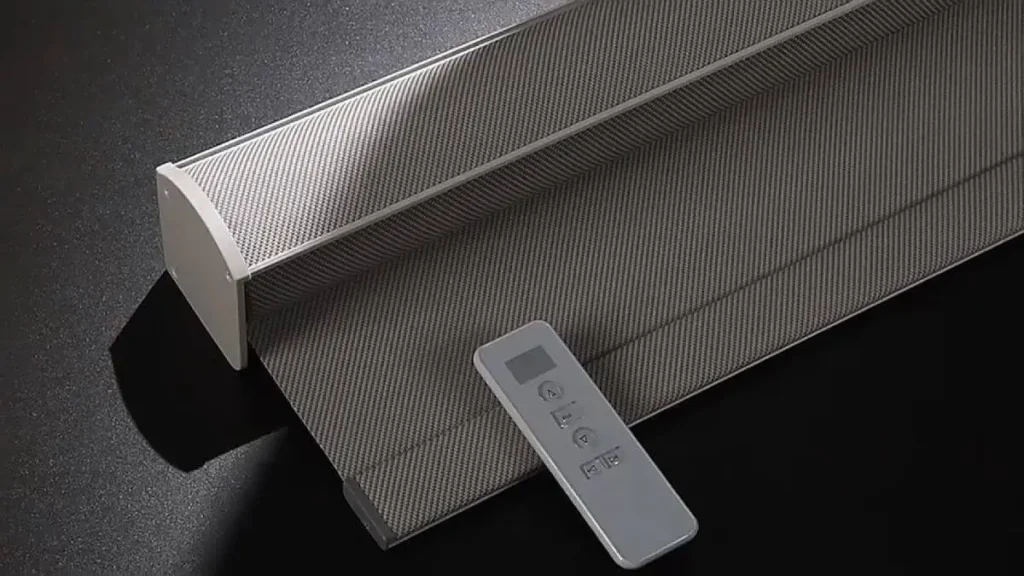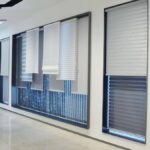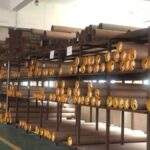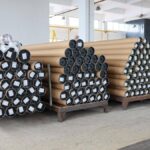In the evolving landscape of modern architecture and interior design, intelligent building solutions are no longer a luxury but a strategic imperative. Among these, automated window blinds stand out as a paramount feature, offering an unparalleled blend of convenience, energy efficiency, aesthetic appeal, and enhanced occupant comfort. From corporate headquarters and hospitality venues to educational institutions and multi-family residential complexes, the demand for smart shading solutions is surging.
However, for architects, developers, facility managers, and interior designers embarking on large-scale projects, one of the most pressing questions often arises early in the planning phase: “How much do automated blinds really cost?” It’s a complex question without a simple answer, as the investment can vary significantly based on a multitude of factors.
At Shadesmart, a leader in innovative and intelligent shading solutions, we understand that understanding the financial implications is crucial for effective project budgeting and decision-making. This ultimate guide is designed to demystify the cost of automated blinds, breaking down the key components that influence pricing and equipping you with the knowledge to make informed choices for your next commercial endeavor. We’ll delve into the core elements that drive costs, explore the value of smart control systems, and consider project-specific factors, ensuring you have a comprehensive understanding of what to expect for your investment in advanced window treatments.

The Core Components Influencing Automated Blind Costs
The price of automated blinds is not a single figure but rather a sum of several critical components. Understanding each element will help you tailor your selections to meet both your project’s aesthetic and budgetary requirements.
Fabric and Material Quality: The Foundation of Performance and Price
The fabric selected for your automated blinds plays a pivotal role in determining their cost, functionality, and longevity. Shadesmart specializes in internal window shades crafted from premium fabrics, recognizing that material quality is paramount for commercial applications.
Premium Fabrics vs. Basic Options: Entry-level fabrics are typically synthetic, offering basic light control and privacy. However, for commercial environments, the demand often shifts to premium, high-performance materials. These include:
- Solar Screen Fabrics: Designed to reduce glare and heat gain while maintaining views, often with varying openness factors (e.g., 1%, 3%, 5%, 10%). Higher-end solar screens offer superior thermal performance and UV protection.
- Blackout Fabrics: Essential for spaces requiring complete darkness, such as conference rooms, auditoriums, or bedrooms in hospitality settings. Premium blackout fabrics are durable, often fire-retardant, and provide excellent insulation.
- Light-Filtering Fabrics: Offering diffused light and privacy without total darkness, ideal for common areas or offices.
- Specialty Fabrics: This category includes acoustic fabrics for sound absorption, antimicrobial fabrics for healthcare environments, or even custom-printed fabrics for branding and unique aesthetics.
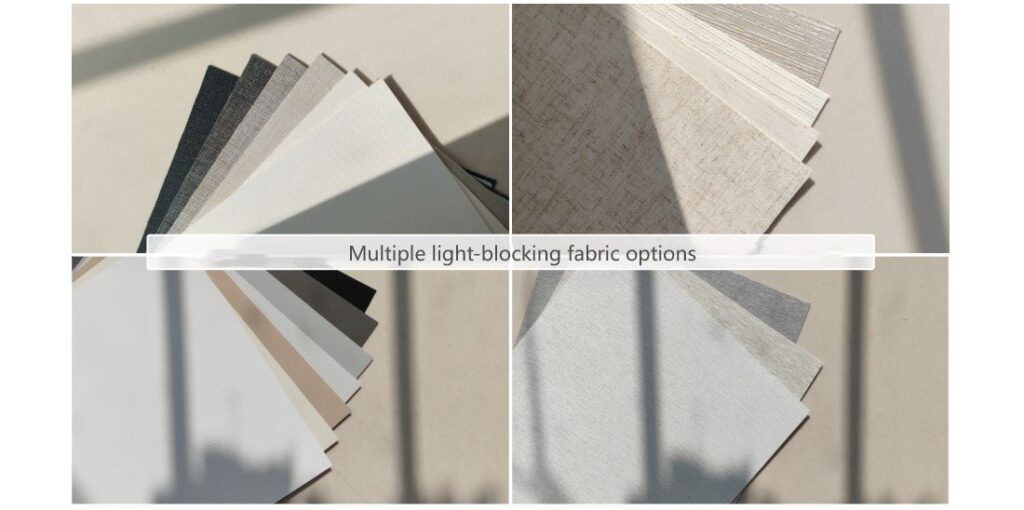
Performance Characteristics: The inherent properties of the fabric directly impact cost.
- Energy Efficiency: Fabrics engineered for superior thermal performance (e.g., those with low U-factors or high R-values) will typically command a higher price but offer significant long-term energy savings.
- Durability and Longevity: Commercial-grade fabrics are designed to withstand heavy use, resist fading, and maintain their appearance over time, reducing replacement cycles.
- Fire Retardancy (NFPA 701, CAL FIRE Title 19): A non-negotiable for most commercial projects, fire-retardant fabrics often add to the cost but are essential for safety and compliance.
- Eco-Friendly and Sustainable Options: Fabrics made from recycled materials, PVC-free components, or those with low VOC emissions align with green building initiatives and can be a higher-cost, value-added choice.
Impact on Cost: While basic fabrics might start at a lower price point per square foot, premium, high-performance, and specialized fabrics can significantly increase the per-blind cost. However, this investment often translates into superior performance, energy savings, extended lifespan, and compliance with stringent commercial building codes. Shadesmart’s commitment to premium fabrics ensures that your initial investment yields superior long-term value and performance.
Motorization Type & Technology: The Heart of Automation
The motor is the engine of your automated blind system, and its selection heavily influences both functionality and cost. Motor technology has advanced rapidly, offering a range of options suitable for different project scales and requirements.
Battery-Powered Motors
- Pros: Easy installation (no wiring required), ideal for retrofits or smaller projects where running new electrical lines is impractical. Can be cost-effective for individual blinds.
- Cons: Requires periodic battery replacement or recharging, which can be a maintenance consideration for large installations. Motor strength may be limited for very large or heavy blinds.
- Cost Impact: Generally lower initial installation costs due to simplified wiring, but ongoing battery costs.
Hardwired (AC/DC) Motors:
- Pros: Highly reliable, robust power delivery for even the largest and heaviest blinds, no battery management, ideal for new construction where wiring can be planned. Centralized power ensures consistent operation.
- Cons: Requires professional electrical wiring, which adds to installation complexity and cost, especially in existing structures.
- Cost Impact: Higher initial installation costs due to wiring, but lower long-term maintenance related to power. Preferred for large-scale commercial projects due to reliability and consistent power.
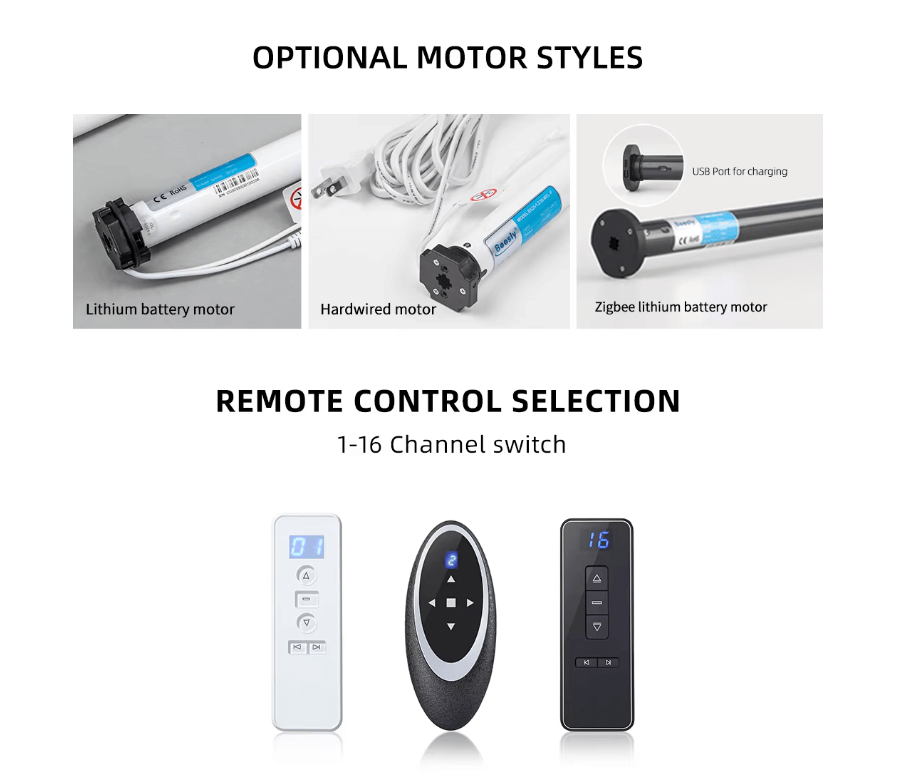
Low-Voltage Motors:
- Pros: Safer to install, often easier to wire than high-voltage, suitable for medium-sized blinds. Can be powered by a single transformer serving multiple blinds.
- Cons: May require a transformer, which adds a component and potentially some installation complexity.
- Cost Impact: Middle ground between battery and high-voltage AC in terms of wiring cost.
Motor Brand and Features:
- Leading Manufacturers: Reputable motor brands (e.g., Somfy, Lutron, Coulisse) are known for their quiet operation, durability, and integration capabilities. These often come at a premium.
- Quiet Operation: Crucial for hospitality, healthcare, and office environments, ultra-quiet motors add to the cost.
- Speed and Torque: Motors designed for very large or heavy blinds will have higher torque and often a higher price tag.
- Bi-directional Communication: Motors that can send feedback to the control system (e.g., exact position) are more advanced and usually more expensive.
**Shadesmart Angle: Shadesmart partners with industry-leading motor manufacturers to ensure the highest quality, reliability, and integration capabilities for our intelligent shading solutions, ensuring smooth, quiet, and dependable operation for years to come. Our expertise allows us to recommend the ideal motor solution for your specific project requirements, balancing performance with budget.
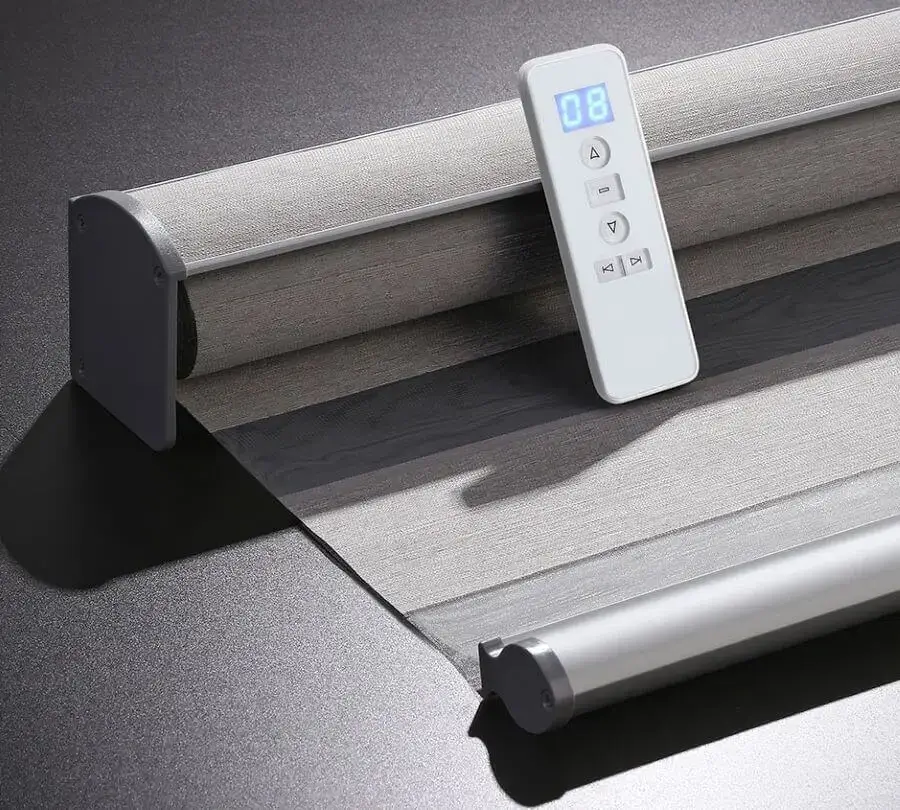
Blind Type & Complexity: Design Dictates Price
The inherent design and complexity of the blind itself significantly contribute to the overall cost. Different blind types offer varying aesthetics and functionalities, impacting manufacturing and motorization requirements.
Roller Shades
- Cost Impact: Generally the most cost-effective automated option due to their simple construction. A single fabric panel rolls up onto a tube.
- Advantages: Sleek, minimalist design; highly versatile with a wide range of fabrics (blackout, solar, decorative); excellent for large windows.
- Shadesmart Offering: Our roller shades are a core product, offering robust motorization for seamless operation across various fabric types.
Zebra Shades (Dual Layer/Sheer & Solid)
- Cost Impact: Mid-range in terms of cost. Their dual-layer design with alternating sheer and opaque fabric sections adds to manufacturing complexity.
- Advantages: Unique light control, allowing for filtered light or complete privacy; modern aesthetic.
- Shadesmart Offering: Automated zebra shades provide sophisticated light management and a distinctive visual appeal.
- Cellular (Honeycomb) Shades:Cost Impact: Can be higher due to their unique cellular construction, which offers superior insulation properties.
- Advantages: Excellent energy efficiency due to trapped air pockets; good sound absorption; soft, diffused light.
- Shadesmart Offering: Our automated cellular shades are perfect for projects prioritizing energy savings and acoustic comfort.
Specialty Shapes and Large Windows
- Cost Impact: Significant increase in cost. Custom-shaped windows (arches, angles, skylights) require specialized manufacturing and motor solutions. Very large or tall windows necessitate heavy-duty motors and custom fabrication.
- Challenges: Precision engineering, specialized motor torque, and complex installation.
- Shadesmart Offering: Shadesmart excels in providing customized solutions for challenging window configurations and oversized openings, ensuring seamless automation even for the most unique architectural designs.
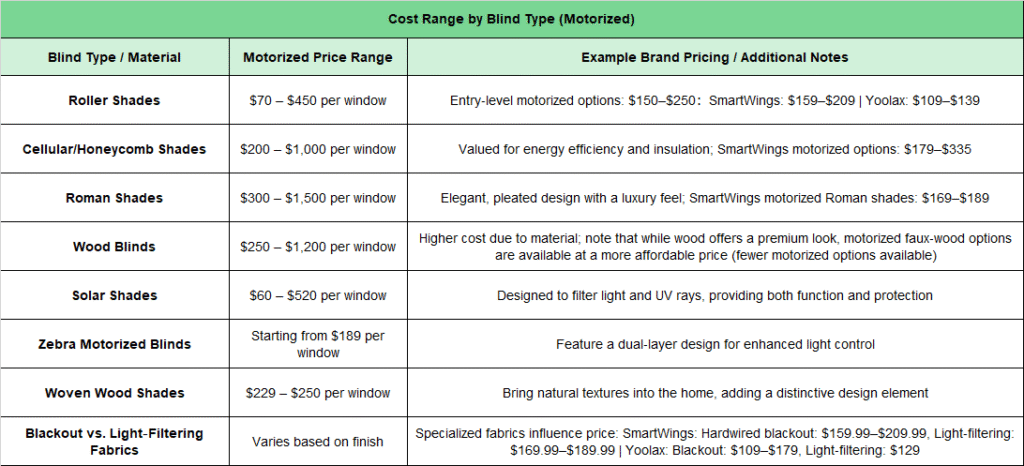
Smart Control Systems: Adding to the Investment (and Value)
Beyond the motor itself, the system used to control your automated blinds is a significant cost factor, but also where much of the ‘smart’ value is derived. The more sophisticated the control, the higher the initial investment, but also the greater the convenience, efficiency, and integration capabilities.
Basic Control Options: Foundation for Functionality
Remote Control
- Cost Impact: Relatively low additional cost per blind/group.
- Functionality: Simple, individual or group control of blinds within line of sight. Handheld or wall-mounted.
Wall Switches
- Cost Impact: Moderate, involves wiring and switch installation.
- Functionality: Fixed points of control, convenient for common areas or specific rooms. Can be wired or wireless.
Advanced Smart Home and Building Management Integration: The Future of Control
This is where automated blinds truly become “smart,” offering unparalleled control and optimization, particularly for large-scale commercial projects.
Smartphone/Tablet App Control
- Cost Impact: Requires a central hub or bridge, which is an additional cost, but then leverages existing mobile devices.
- Functionality: Convenient control from anywhere, scheduling, scene creation (e.g., “morning scene” opens all blinds to 50%).
Voice Control Integration (Alexa, Google Home, Siri)
- Cost Impact: Minimal added cost if compatible smart speakers are already present; relies on the central hub/bridge.
- Functionality: Hands-free operation, highly intuitive for users.
Building Management System (BMS) Integration
- Cost Impact: Can be a significant cost due to the complexity of integration protocols and software. Essential for sophisticated commercial buildings.
- Functionality: Centralized control and monitoring of all building systems, including HVAC, lighting, security, and window treatments. Enables advanced energy management strategies, automatic climate response, and data logging.
**Shadesmart Angle: Shadesmart’s intelligent shading solutions are designed for seamless integration with a wide range of leading smart building management systems. This capability is critical for large commercial projects seeking to optimize energy consumption, enhance occupant comfort, and achieve certifications like LEED or WELL. Our experts can advise on the best integration pathways for your specific BMS, ensuring your automated blinds become a truly integrated part of your building’s intelligent ecosystem.
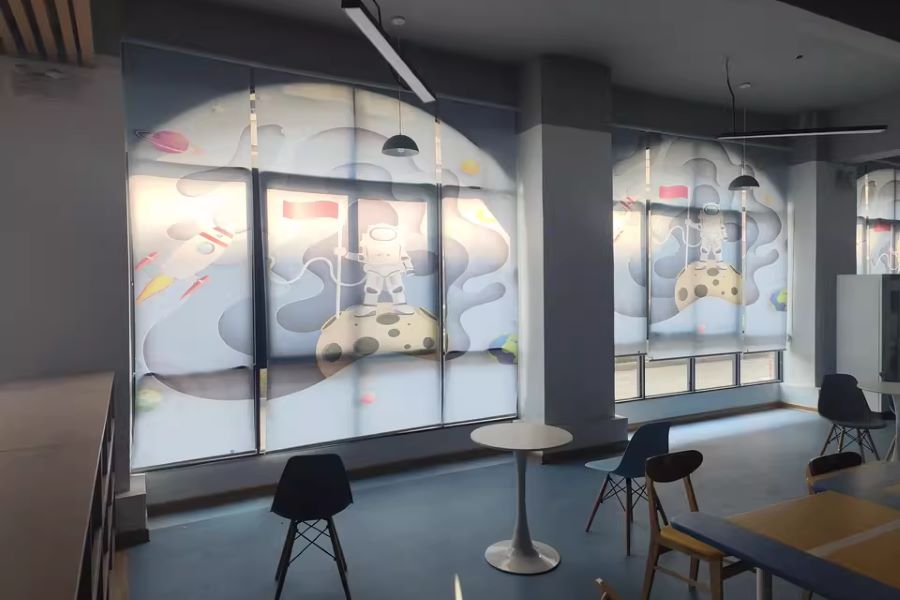
Sensors and Automated Responses
Cost Impact: Additional sensors add to the cost per location.
Functionality
- Light Sensors: Automatically adjust blinds based on ambient light levels to optimize daylighting and reduce glare.
- Temperature Sensors: Adjust blinds to manage heat gain/loss, working in conjunction with HVAC systems.
- Occupancy Sensors: Adjust blinds when rooms are unoccupied to save energy.
- Timer/Astronomical Clocks: Program blinds to open/close based on time of day, sunrise/sunset, or pre-set schedules, eliminating manual intervention.
Network Infrastructure
The reliability of your control system depends on a robust network. Whether it’s Wi-Fi, Zigbee, Z-Wave, or a proprietary low-voltage network, establishing this infrastructure adds to the initial setup cost.
Installation & Project-Specific Factors: The Unseen Costs
While the product components make up the bulk of the material cost, several project-specific factors and installation considerations can significantly influence the final investment.
DIY vs. Professional Installation: A Critical Decision for Commercial Projects
While DIY might seem appealing for a single residential blind, it is strongly discouraged, if not impossible, for commercial automated blind installations.
Professional Installation is Paramount
- Expertise: Automated blind systems require precise measurements, often complex wiring (especially for hardwired systems), motor programming, and integration with control systems.
- Efficiency for Scale: For hundreds or thousands of blinds in a commercial building, professional installers have the tools, teams, and experience to complete the project efficiently and accurately, minimizing disruption.
- Warranty Compliance: Many manufacturers require professional installation for their warranties to remain valid.
- Safety: Dealing with electrical components and working at heights requires trained personnel and adherence to safety protocols.
- Cost Impact: Professional installation adds a significant component to the overall cost, typically ranging from 10-30% of the product cost, depending on complexity. However, it’s an investment that ensures proper function, and longevity and avoids costly mistakes.
**Shadesmart Angle: While Shadesmart provides world-class products, we strongly advocate for professional installation for our commercial projects. Our network of certified installers is equipped to handle projects of any scale, ensuring seamless integration, flawless operation, and adherence to all building codes and safety standards. We can also provide detailed installation guidance for your preferred contractors.

Wiring Requirements: New Construction vs. Retrofit
The existing electrical infrastructure of your building is a major cost driver for automated blinds.
New Construction
- Cost Impact: Generally more cost-effective. Wiring for hardwired motors can be planned and integrated into the building’s electrical system from the outset, minimizing labor and disruption.
- Opportunity: Allows for optimal placement of switches and control points.
Retrofit Projects
- Cost Impact: Can be significantly higher. Running new electrical lines in an existing building often requires opening up walls, patching, and painting, leading to increased labor and material costs.
- Solution: Battery-powered motors are often a more viable (and cost-effective) option for retrofits, though they introduce ongoing battery management. Low-voltage systems can also be easier to implement.
Project Size & Scope: Economies of Scale
The larger your project, the more opportunity there is for cost efficiencies per unit.
- Bulk Ordering: For commercial projects requiring hundreds or thousands of blinds, manufacturers like Shadesmart can offer significant discounts on materials and motors due to economies of scale.
- Standardization: Using consistent blind types, fabrics, and motor models across a large project can streamline manufacturing and reduce unique component costs.
- Project Management: Large projects benefit from dedicated project management, which while an overhead, ensures efficiency and coordination, ultimately saving time and money.
**Shadesmart Angle: Shadesmart specializes in large-scale commercial and multi-family residential projects. Our robust manufacturing capabilities and dedicated project teams are structured to handle bulk orders efficiently, providing competitive pricing and seamless execution from design to installation. We are adept at managing complex logistics and delivering consistent quality across thousands of units.
Customization & Special Features: Tailoring Comes with a Price
While customization is key to achieving specific design and functional goals, each unique element adds to the overall cost.
- Custom Printing: For branding or unique aesthetic requirements, adding custom graphics or patterns to fabrics.
- Fascia and Cassette Options: Decorative headboxes or valances to conceal the motor and roller mechanism. These can be standard or custom-finished.
- Side Channels: Used for complete light blockage (e.g., in blackout rooms) or to improve thermal performance. These add materials and installation complexity.
- Motor Pockets/Recessed Installation: Creating integrated architectural elements to hide the blind mechanism within the ceiling or wall adds to construction costs.
- Specialty Hardware: Unique brackets, controls, or mounting solutions for unusual window configurations.
Conclusion: Investing in Smart, Sustainable Spaces with Shadesmart
The “cost” of automated blinds is a nuanced figure, influenced by a dynamic interplay of fabric quality, motor technology, blind type, control system sophistication, and critical project-specific factors like installation complexity and project scale. While the initial investment for a comprehensive automated shading system might appear substantial, it’s crucial to view it as a strategic long-term asset for your commercial property.
Automated blinds offer significant returns on investment through:
- Reduced Energy Consumption: Leading to substantial savings on HVAC costs.
- Enhanced Occupant Comfort and Productivity: By optimizing natural light, reducing glare, and improving privacy.
- Increased Property Value and Appeal: Modernizing spaces and attracting tenants or buyers.
- Streamlined Facility Management: Through centralized control and automation.
At Shadesmart, we are dedicated to providing innovative, eco-friendly, and intelligent shading solutions that meet the diverse needs of modern commercial and large-scale residential projects. We specialize in designing and manufacturing high-quality motorized window treatments that are built to last, integrate seamlessly, and provide measurable value.
Ready to get a precise quote for your commercial project? Don’t navigate the complexities of automated blinds cost alone. Our team of experts is ready to partner with you from conception to completion. Contact Shadesmart today for a personalized consultation, and detailed cost breakdown, and to explore how our high-quality, customizable bulk shading solutions can elevate your next project. Let us help you transform your vision into a truly intelligent and efficient space.
Connect with Shadesmart and discover the smart choice for your window covering needs.

